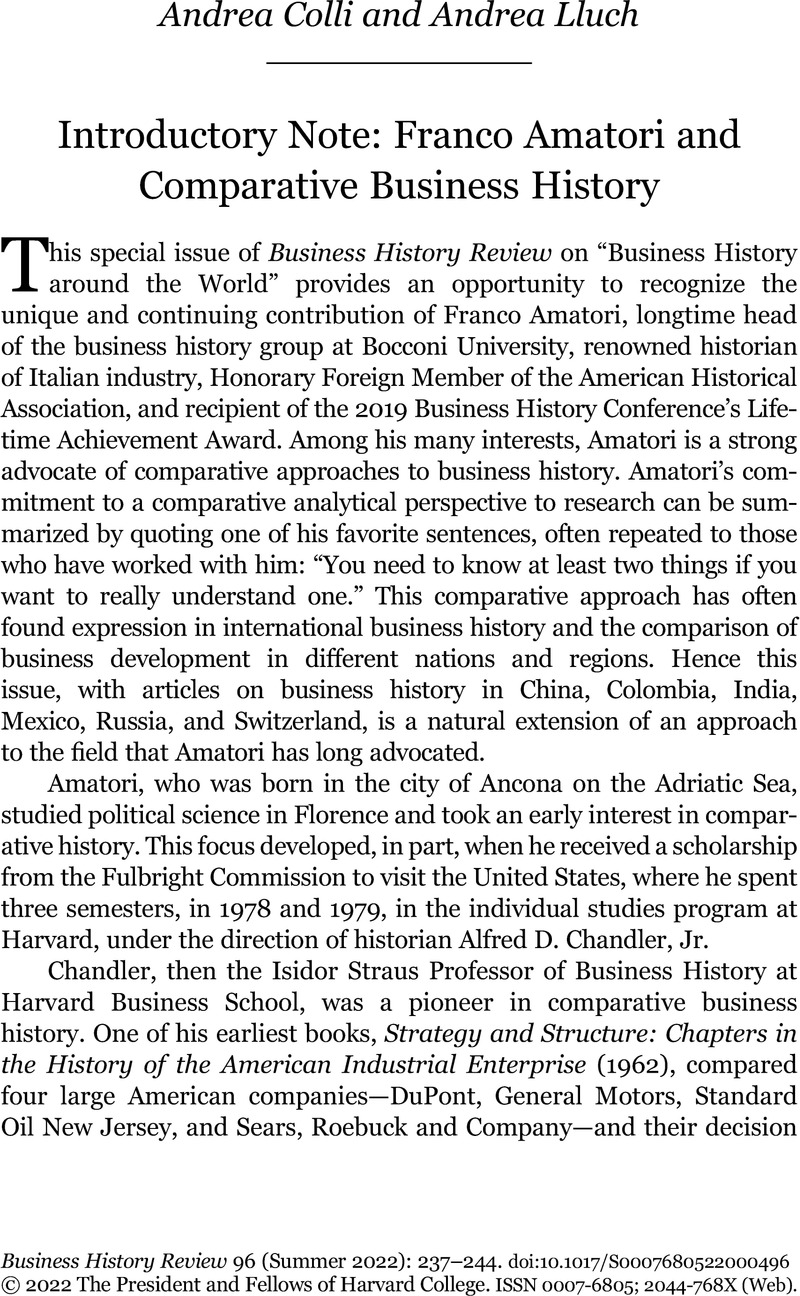Article contents
Introductory Note: Franco Amatori and Comparative Business History
Published online by Cambridge University Press: 29 July 2022
Abstract

- Type
- Introduction
- Information
- Business History Review , Volume 96 , Issue 2: Business History around the World , Summer 2022 , pp. 237 - 244
- Copyright
- Copyright © 2022 The President and Fellows of Harvard College
References
1 Chandler, Alfred D. Jr., Strategy and Structure: Chapters in the History of the American Industrial Enterprise (Cambridge, MA, 1962)Google Scholar.
2 Chandler, , The Visible Hand: The Managerial Revolution in American Business (Cambridge, MA, 1977)Google Scholar.
3 Chandler, with Hikino, Takashi, Scale and Scope: The Dynamics of Industrial Capitalism (Cambridge, MA, 1990)Google Scholar.
4 Wilkins, Mira, “Chandler and Global Business History,” Business History Review 82, no. 2 (Summer 2008): 251-266CrossRefGoogle Scholar. Wilkins provides an overview of Chandler’s growing interest in comparative global business history.
5 See Channon, Derek, The Strategy and Structure of British Enterprise (Boston, 1973)CrossRefGoogle Scholar; Dyas, Gareth and Thanheiser, Heinz, The Emerging European Enterprise: Strategy and Structure in French and German Industry (London and Basingstoke, 1976)CrossRefGoogle Scholar; Pavan, Robert J., Strutture e strategie delle imprese italiane (Bologna, 1976)Google Scholar. Also see Pavan, , “Strategy and Structure: The Italian Experience,” Journal of Economics and Business 28, no. 3 (1976): 254–60Google Scholar. For this cohort’s doctoral work, see: Channon, “The Strategy and Structure of British Enterprise,” (Ph.D. diss., 1971); Dyas, “The Strategy and Structure of French Industrial Enterprise,” (Ph.D. diss., 1972); Thanheiser, “Strategy and Structure of German Industrial Enterprise” (Ph.D. diss., 1972); and Pavan, “The strategy and structure of Italian enterprise,” (Ph.D. diss., 1972).
6 Hannah, Leslie, The Rise of the Corporate Economy: The British Experience (Baltimore, 1976)Google Scholar; and Chandler, Alfred D. and Daems, Herman, eds., Managerial Hierarchies: Comparative Perspectives on the Rise of the Modern Industrial Enterprise (Cambridge, MA, 1980)Google Scholar.
7 Wilkins, “Chandler and Global Business History,” 253–254.
8 Chandler, , La mano visibile: La rivoluzione manageriale nell'economia americana, trans. Amatori, Franco (Milan, 1981)Google Scholar; and Chandler, , Dimensione e diversificazione: Le dianmiche del capitalismo industriale, ed Amatori, Franco, trans. Zecchin, Fabrizio, Battilani, Patrizia, and Cantarini, Paola (Bologna, 1994)Google Scholar.
9 See, for example, Amatori, , “Reflections on Global Business and Modern Italian Enterprise by a Stubborn ‘Chandlerian,’” Business History Review 71, no. 2 (Spring 1997): 309–318CrossRefGoogle Scholar.
10 Amatori, “Entrepreneurial Typologies in the History of Industrial Italy (1880–1960), Business History Review 54, no. 3 (Autumn 1980): 365.
11 Amatori, 359.
12 Amatori, 360.
13 See, for example, Amatori, , “The Fascist Regime and Big Business: The Fiat and Montecatini Cases,” in Enterprise in the Period of Fascism in Europe, ed. James, Harold and Tanner, Jakob (New York, 2002), 62–77Google Scholar; Amatori, , Proprietà e direzione: la Rinascente, 1917–1969 (Milan, 1989)Google Scholar; and Amatori, , Impresa e mercato: Lancia, 1906–1969 (Milan, 1996)Google Scholar.
14 Amatori, Franco and Colli, Andrea, Impresa e industria in Italia dall'Unità ad oggi (Venice, 2000)Google Scholar.
15 At the moment, the publication of the dictionary has been suspended by the Instituto dell'Enciclopedia Italiana. Notwithstanding this, around six hundred entries have been completed and, in part, published in the Italians’ biographic dictionary, by the same Instituto dell'Enciclopedia Italiana.
16 Amatori, , “Business History: State of the Art and Controversies,” Enterprise et Histoire, 15, no. 2 (June 2009), 15Google Scholar.
17 This conference's proceedings were published in the first volume of the above-mentioned series “Comparative Perspectives in Business History”: Toninelli, Pier Angelo, ed., The Rise and Fall of State-Owned Enterprises in the Western World (Cambridge, UK, 2000)CrossRefGoogle Scholar.
18 Here the complete list of the conferences: “The Rise and Fall of State-Owned Enterprise in the Western World” (1996); “Business History around the World at the End of the Twentieth Century” (1998); “The Global Chemical Industry in the Age of the Petrochemical Revolution” (2000); “Entrepreneurs and Managers” (2002); “Business Performance in the Twentieth Century: A Comparative Perspective” (2004); “Has There Been a Third Industrial Revolution in Global Business?” (2006); “Business and the Chinese Miracle” (2008); “A Special Kind of Business: The Cooperative Movement, 1950–2010. . .and Beyond” (2010); “Capitalism and the Corporation: Today and Yesterday” (2014); and “Business History in the Age of Modern Globalization” (2017).
19 Galambos, Louis, Hikino, Takashi, and Zamagni, Vera, eds., The Global Chemical Industry in the Age of the Petrochemical Revolution (Cambridge, UK, 2007)Google Scholar; Toninelli, Rise and Fall of State-Owned Enterprise in the Western World; Battilani, Patrizia and Schröter, Harm G., The Cooperative Business Movement, 1950 to the Present (Cambridge, UK, 2012)CrossRefGoogle Scholar; Dosi, Giovanni, Galambos, Louis, Gambardella, Alfonso, and Orsenigo, Luigi, The Third Industrial Revolution in Global Business (Cambridge, UK, 2013)CrossRefGoogle Scholar; Naughton, Barry and Tsai, Kellee S., eds., State Capitalism, Institutional Adaptation, and the Chinese Miracle (Cambridge, UK, 2015)CrossRefGoogle Scholar.
20 Amatori, Franco and Jones, Geoffrey, eds., Business History around the World (Cambridge, UK, 2003)CrossRefGoogle Scholar.
21 Amatori and Jones, Business History around the World. The book featured sections on general topics, including on the boundaries of business history (Louis Galambos), innovative enterprise (William Lazonick), and flexibility, governance, and strategic choice (Jonathan Zeitlin). It also included sections on “area patterns,” including on the United States (William J. Hausman), Britain and the Netherlands (Geoff Jones and Keetie Sluyterman), Scandinavia (Hakan Lindgren), Germany (Harm Schröter), France (Yousef Cassis), Italy (Granco Amatori and Giorgio Bigatti), Spain (Albert Carreras, Xavier Tafuneli, and Eugenio Torres), Greece (Margarita Dritsas), Japan (Akira Kudo), China (Chi-Kong Lai), and Latin America (Maria Ines Barbero). A third section on comparative business history included articles on family firms (Andrea Colli and Mary B. Rose), multinationals (Geoffrey Jones), and the dynamics of government-based relations (Mathias Kipping).
22 Amatori and Jones, “Introduction,” in Amatori and Jones, Business History around the World, 6.
23 Amatori, , “Business History as History,” Business History, 51, no. 2 (March 2009): 146CrossRefGoogle Scholar.
- 1
- Cited by


